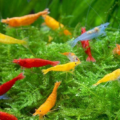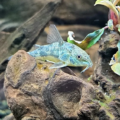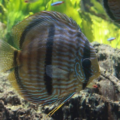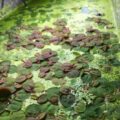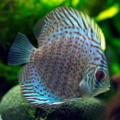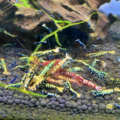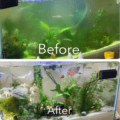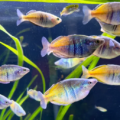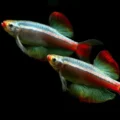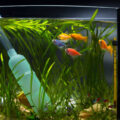Come checkout the best beginner-friendly warm-toned fish species to embrace autumn’s warmth in your aquarium including care tips for beginners and pro aquarists.
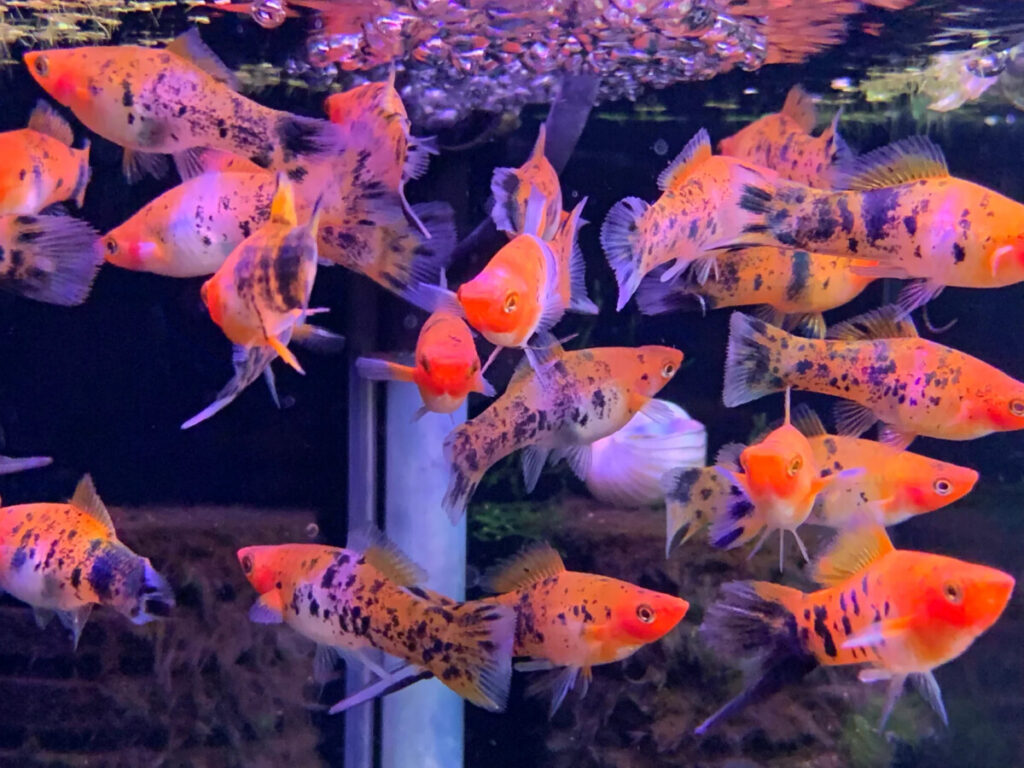
Why Warm-Toned Fish Suit Autumn Themes
Did you know you can create an autumn-themed tank using warm toned aquarium fish? Seasonal aquascaping is one of the ways to implement cozy tank ideas.
Fish species with fins and scales in reds, oranges, and golds to match your environment, will bring your autumn aquarium theme alive.
From red orange fish like Swordtails, golden Mollies, jeweled Discus and short-lived gems like Killifish, this guide points you to the best autumn fish to highlight your warm palette aquascape.
Author’s Note: Check out our post on The 9 Essential Autumn Aquarium Maintenance Tasks to keep these warm-toned fish healthy!
1| Swordtails – Fiery Orange & Red

We’ll open this list with the Swordtail species, an ornamental, fiery red aquarium fish. It’s a variant of the livebearing species with vivid swordtail fish colors like tangerine, blood red, and a rare mixed patterned red and orange.
You’ll find some male orange swordtail fish with red morphs and vice versa. Swordtails are active swimmers who love swimming from the top to the center of the water. This trait makes them enjoyable to watch and they make redfish-orange visions across your tank.
Add this species to your tank for warm aquarium accents.
Care Tips for Swordtails
Maintain a freshwater temperature level of 72 – 82F, pH between 7 and 8 and hardness of 12 – 30dGH in a 15 gallon tank per single fish. Make partial water changes of 10 – 25% weekly to keep the environment clean and pristine.
Secure the tank with a breathable but escape-proof lid to prevent the Swordtail fish from jumping out.
Feed them a varied diet of rich-proteinous, live and commercial and plant-based foods. They’re rich algae eaters which is great for keeping the tank clean during autumn.
Author’s Note: Check out our post Are Swordtails Easy To Keep for even more on these beginner friendly fish!
2| Platies – Versatile & Hardy

If you want an affordable, beginner-friendly autumn fish, Platies are your best option. The unique platy fish colors range from sunset reddish-orange to gold strains. The sunset platy is more common than the gold variant but they have the same care needs and personality traits.
This sunset and gold aquarium fish can move in groups so if you’re keeping a single Platy, get a 10 gallon tank while two or more Platies need 5 gallons more water per fish addition.
Aquarists with small to medium-sized tanks looking for easy maintenance seasonal aquarium livebearers can stop here.
Care Tips for Platies
Platies love swimming so create open areas within your aquascape for them to express themselves. Add live plants for interactive benefits.
As a hardy fish, set the water parameters to 6.8 – 8.5 pH level, 70 -82F water temperature and high mineral content water.
Platies survive on a varied diet of live and plant foods. Feed them once to thrice daily but in small portions that they would finish in under 2 minutes. Portion control aids digestion and prevent wastage.
Author’s Note: Check out our post on How Many Platies Should Be Kept Together for more on keeping schools of these beginner friendly fish!
3| Mollies – Gold & Black Contrast

With molly fish varieties like golden, dalmatian, and orange morphs, you can create a black and gold contrast in your autumn tank. It tones down the vibrancy of autumn warm tones without drowning in its shades.
Mollies are typically long, thick and have pointed heads, with their entire bodies growing up to 2 – 7 inches. You’ll recognize them though by their uniquely patterned bodies.
With gold molly fish, you may see black flecks in their typically plain golden scales, Dalmatian mollies are white with black spots while black mollies, a rare variant, are completely black up to the eyes and fins.
Care Tips for Mollies
To properly run a black, golden, Dalmatian or orange molly aquarium, you must understand its specific care needs based on its characteristics.
For example, this species is a livebearer unlike other fish species that lay eggs. So provide livebearer care like setting a warm water temperature between 75 – 80F, a pH level of 7.5 – 8.5 and change the water weekly between 25 – 33% to maintain cleanliness.
Note that even though these livebearers thrive in varied water conditions, they need stability.
4| Cherry Barbs – Autumn Red Schoolers
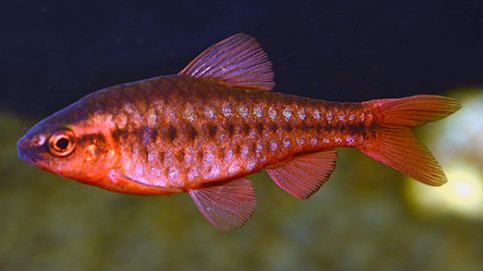
Cherry barb colors depend on their sex so, to get that vibrant red shade, you must choose the male species. However if you don’t mind a mix of soft pinkish-brown tones in your school, you can add females to the mix.
Despite their 1.5 – 2 inches bodies, these vibrant small barbs are active swimmers with an inquisitive nature.
Cherry red fish species are peaceful barbs that enjoy schooling and interacting with their environment. So, it’s best to keep this red schooling fish in groups of six or more.
Here are some care tips for aquarium maintenance including tank size, aquascaping, water parameters and feeding this community fish for color enhancement and retention.
Care Tips for Cherry Barbs
Get a 25 gallon tank minimum for a small group of six. Decorate the aquarium with dense live plants, driftwood and rocks but leave enough space in the center for schooling.
Set the water temperature between 74 – 80F and maintain a slightly acidic pH between 6.0 – 7.5. Although Cherry Red fish can tolerate soft and hard water, they thrive better in 2 – 15dGH hardness.
To maintain their vibrant red color, feed this species omnivorous foods that are rich in carotenoids. Finally, ensure they move in species-specific schools or live with peaceful community fish like Tetras, Danios, and Corydoras Catfish.
Author’s Note: Check out Comprehensive Guide to Cherry Barbs for an in-depth beginner friendly guide to these colorful fish!
5| Rosy Barbs – Pinkish-Gold Glow

Another species of hardy barbs that bring an autumn vibe to your tank is the Rosy Barb variant. It’s larger than Cherry barbs as an adult stretches up to 4 inches long which is double the size.
Its unique coloration of rosy and sometimes orange hue for males and pale golden yellow scales for females makes this gold barb fish stand out.
Like the Cherry Barb, Rosy Barb is also an active schooling fish species that needs an interactive environment to fully express itself.
Here’s how to ensure rosy barb care in a cool temperature environment.
Rosy Barb Care Tips
Get a minimum tank size of 30 gallons for a group of 6 Rosy Barbs and fill it with 64 – 72F water. Set the pH level range between 6 and 8 and use an air pump to simulate strong currents.
Rosy Barbs are jumpers so secure them in your tank with breathable escape-proof lids. To keep a peaceful school, ensure females are always more than males using a 2:1 ratio. So, for a group of six, that’s 4 females with 2 males.
6| Discus – Fall Jewel Centerpieces

Let’s look at a show stopping cichlid that makes for a pretty centerpiece in a fall-inspired tank. This species’ appeal lies in the wide variety of discus fish colors that exist. So you can easily select the oranges, reds, and browns as your centerpiece.
Some vibrant discus morphs you can explore include Red Marlboro Discus, Red Pigeon Discus, Brown Discus, Yellow Melon Discus, and Red Turquoise Discus. These species can grow up to 9 inches in diameter with their flat, disk-like shapes.
Here are the best tips for maintaining an autumn red discus aquarium.
Care Tips for Discus fish
Because of their size, Discus fish need at least 55 gallons of water to accommodate a small school of 4 to 5 or 75 gallons for a school of six.
Maintain stable water conditions with a temperature of 83 – 86F, PH of 6 – 7, and hardness between 1 and 4. Unlike other beginner-friendly fish in this overview, the autumn-like variants of this species like the Orange Discus require advanced care.
Author’s Note: Check out our post on the Top 15 Stunning Discus Fish Types for Your Aquarium!
7| Goldfish Varieties – Classic Warm Glow

For a classic warm glow, choose cozy fish species like Fantails, Ryukins, and Comets in autumn shades like gold, orange, and red.
Because of their striking colors, these red, gold and orange aquarium fish stand out against dark substrates. Use fine sand that’s gentle against their bodies so they don’t suffer injuries as they move within the aquascape.
You can mix red fancy goldfish with other compatible variants for a diverse tank. Follow these tips to maintain vibrant Autumn goldfish colors.
Care Tips for Goldfish Varieties
Start your goldfish aquarium with 30 gallons of water per one. Set the temperature at 68 – 74F for coolness and maintain its cleanliness by changing 20 – 30% of the water weekly.
Note that all goldfish produce high waste content so, ensure you exercise portion control during feeding and use a large filter to keep the water pristine.
Finally because this species is ornamental and extra sensitive, ensure the tank has smooth and rounded edges to keep them safe.
Author’s Note: Check out our post on the 15 Types of Goldfish for Your Aquarium!
8| Killifish – Short-Lived Autumn Gems

As we wrap up this list, let’s review a rare aquarium fish that shines brightest under brilliant seasonal light. The Killifish with its warm patterns is a certified showstopper for every tank.
If you want a unique and exotic seasonal species to grace your autumn tank, Killifish is the one for you.
Killifish are carnivores from the West African rivers with distinctive characteristics. The killifish colors range from vibrant orange for males to drab browns for females so choose carefully.
Use the orange killifish for a bold autumn theme and ensure you provide the utmost care to prevent premature death.
Care Tips for Killifish
Set a temperature of 68 – 75F in shallow waters with dense live plants like the West African streams. Cover the tank with a secure lid to keep your pets from jumping out.
Feed Killifish live foods for a rich protein source and to satisfy their carnivorous palates. Ensure there’s an adequate female to male ratio in the tank to avoid territoriality and aggression. A standard ratio is 3:1 female to male.
With proper care, your orange Killifish can live for up to 5 years.
9| Dwarf Gourami – Red Flame & Sunset Strains

Finally, we’ll close this Autumn-themed aquarium pets list with a peaceful and vibrant centerpiece fish, the Dwarf Gourami. For the purpose of the Fall theme, you must select flame gourami colors like warm orange and red morphs.
Besides the various dwarf gourami colors you can choose from, this species’ most unique feature is its air-breathing skills. It’s also wonderful for community tanks because of its calm temperament.
Here’s how you can set up and maintain an Autumn red gourami aquarium.
Care Tips for Dwarf Gourami
Dwarf gouramis are small fish so a 10 – 20 gallon tank per single fish is ideal. Set a water parameter of 72 – 82F temperature, pH of 6 to 8, and hardness between 5 – 20dGH.
This species prefers slow moving waters with dim lighting, and dim lighting. They’re high to mid level swimmers due to their air breathing nature. So, cover the tank with floating plants and dense vegetation.
Dwarf Gouramis eat high-quality commercial foods with live food and plant matter.
Conclusion: Designing a Cozy Autumn Tank
With any of these nine species, you can start building your warm color fish tank. Combine each warm-toned species with contrasting tank decor like dark driftwood, amber lighting to set the mood, and dark substrate such as black sand.
Seasonal tank themes like the autumn aquarium design improves your tank’s aesthetics and boosts enjoyment. As the season changes, you can switch from a cozy fall aquarium to a frosty winter escape, vibrant summer haven or spring paradise.
Experiment with your seasonal cozy tank setup. Explore different substrates and aquascapes until you settle on a design that resonates with you. Happy styling.

